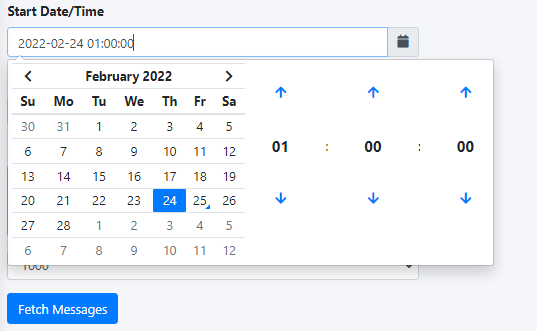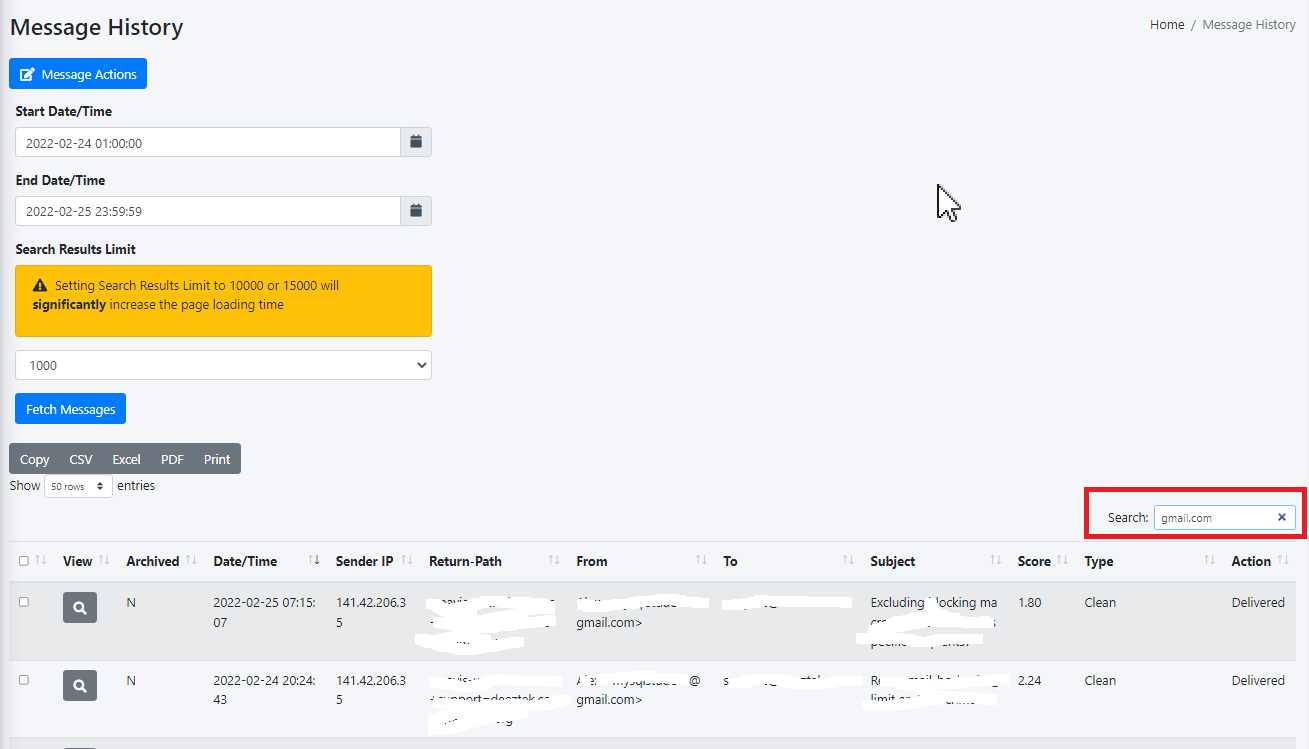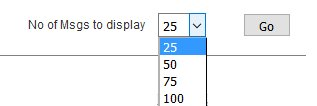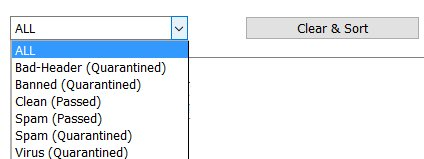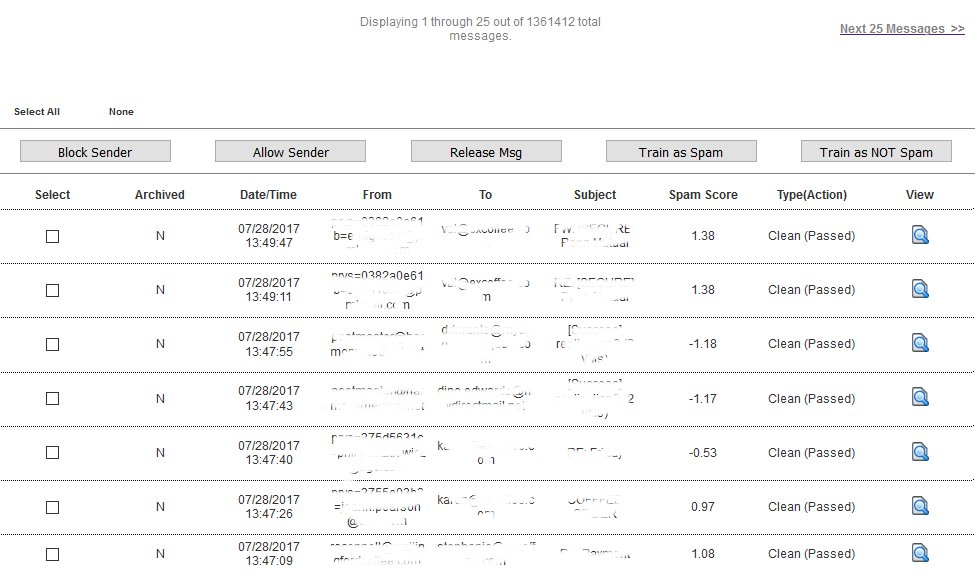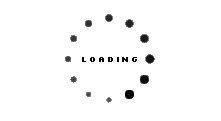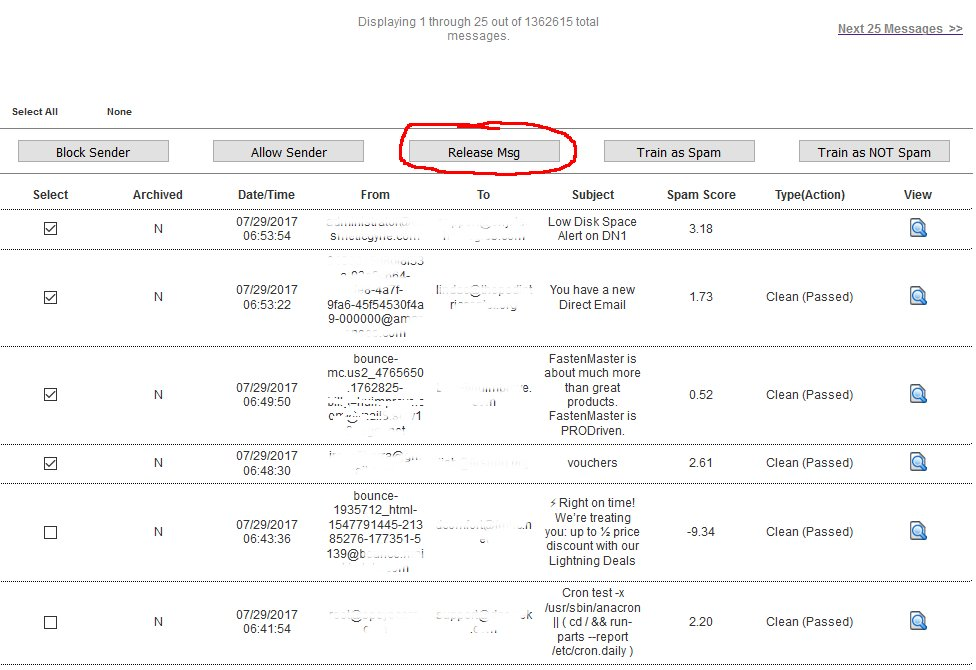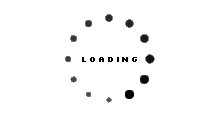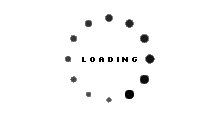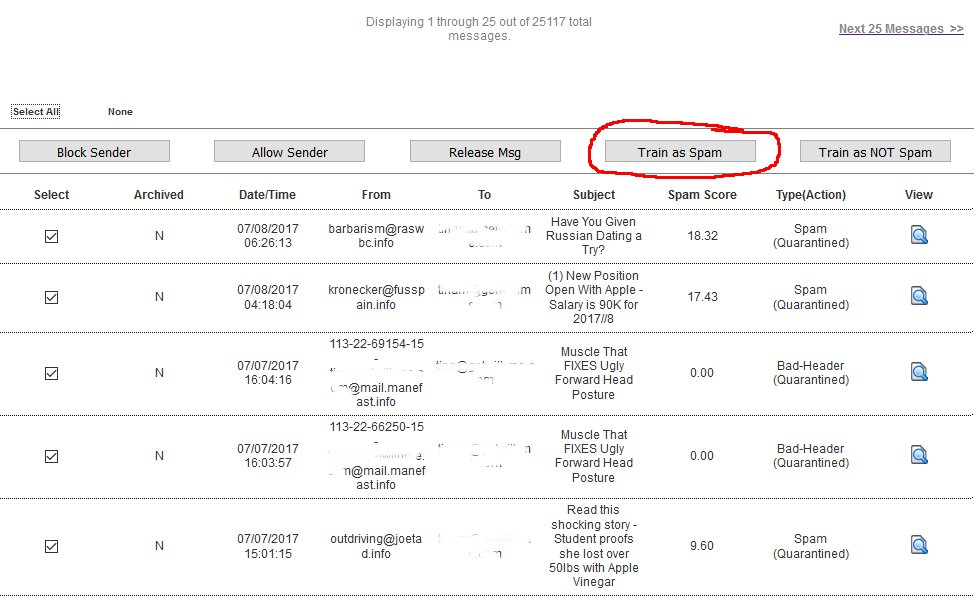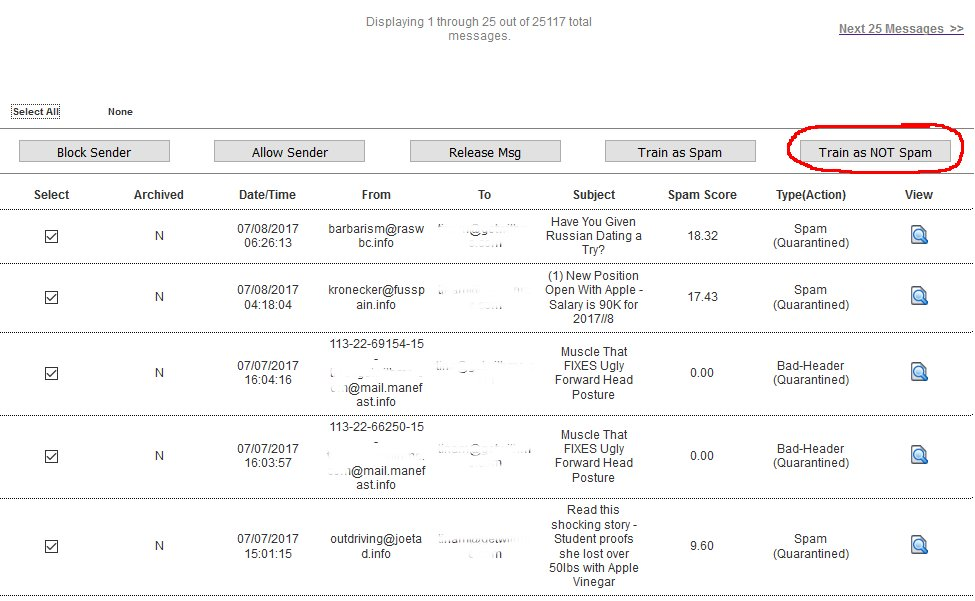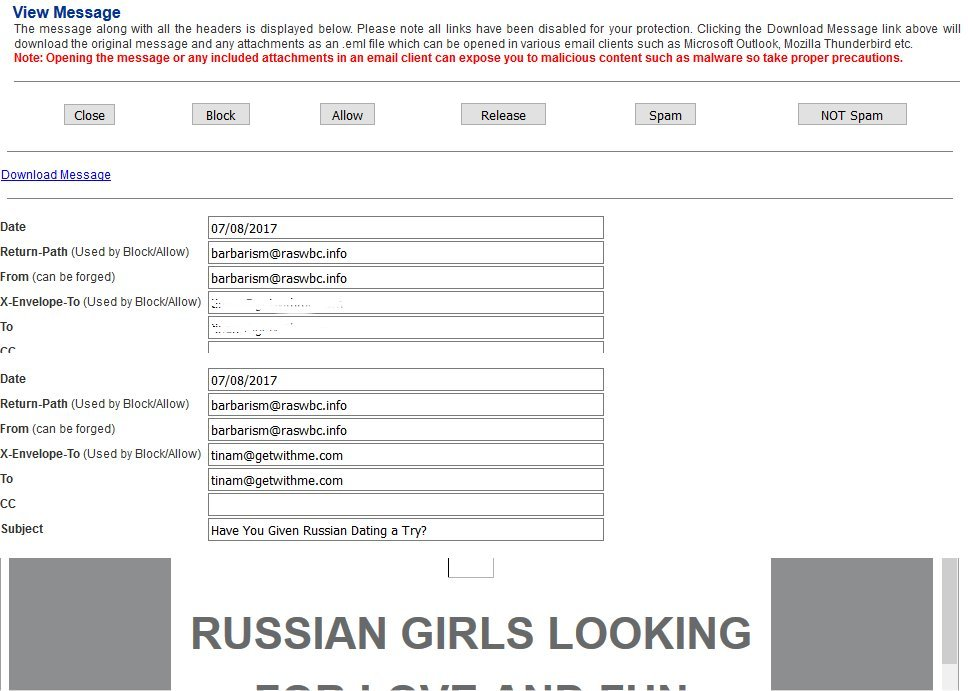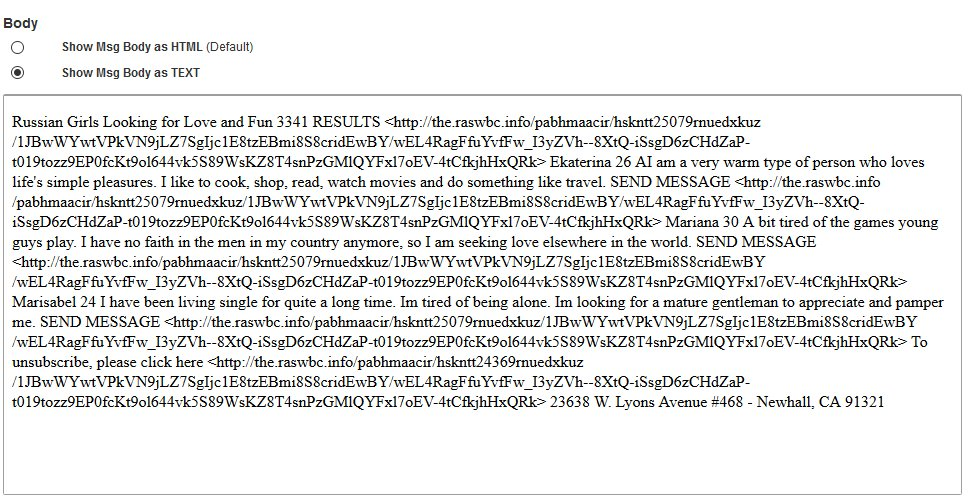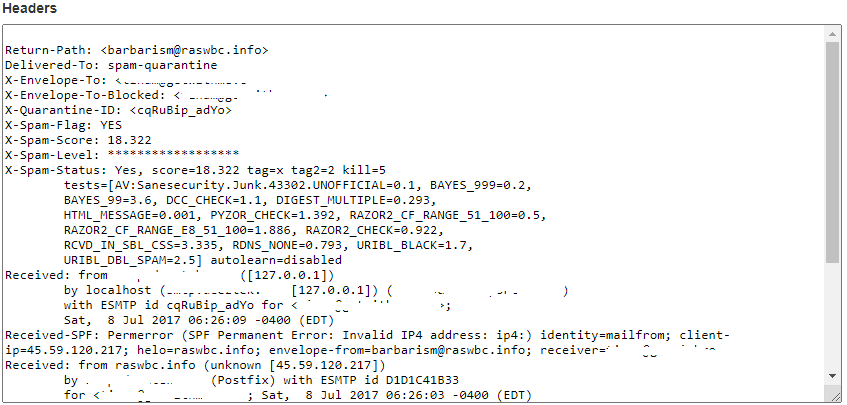Message History
HermesMessage SEGHistory keepsallows ayou logto andsearch, aview, copyrelease of each email message it sends and receives to/from your email address for archiving purposes.
You can easily see the data/time of the oldest message that the system has retained specificmessages to your emailmailbox as well as block/allow senders.
By default, Message History shows a maximum of 1000 messages send to your e-mail address by looking onover the upperpast right-hand24 cornerhours. The maximum messages limit can be increased by adjusting the Search Results Limit drop-down to 1500, 2500, 5000, 10000 or 15000 messages. Be aware that limits of the10000 or 15000 will significantly increase page inloading the Earliest Message Date/Time fieldtime (Figure 1).:
Figure 1
Search Messages
Message History relies on Start Date/Time and the End Date/Time to quickly locate messages. It's important that you have a approximate date and time of the message you are searching for best results.
- Adjust the Start Date/Time and the End Date/Time fields by clicking on the
 icons and adjust the date and time as desired and then click the Fetch Messages button. You can also manually enter the desired date and time (Figure 1):
icons and adjust the date and time as desired and then click the Fetch Messages button. You can also manually enter the desired date and time (Figure 1):
Figure 1
- Once you have a listing of messages in the desired date/time period, search for the actual message(s) by entering a string or multiple strings separated by a space (E-mail Address, Sender IP Address, Subject, Score, Type or Action) in the Search: field (Figure 2)
Figure 2
In this page you will be able to perform the following functions:
- Set the Number of Mesages to Display
- Sort Email Messages
- Search Email Messages
- Release Email Messages to your Mailbox
- Create Block & Allow Sender Rules
- Train the Bayes Database
- View & Download Email Messages
For security reasons, the following keywords are not allowed in any search field:
- Select
- Update
- join
- delete
- insert
- all
- drop
Set the Number of Messages to Display
By default the Message History & Archive page displays 25 messages at a time. You can select to display 50, 75 or 100 messages at a time.
- Click on the the drop-down fnext to the No of Msgs to display field, select the number of messages you wish to display and click on the Go button (Figure 2).
Figure 2
Sort Email Messages
- Click on drop-down field containing the messages types, select a message type you wish to sort for and click on the Clear & Sort button (Figure 3).
Figure 3
You can sort by the following types of messages:
- ALL - These selection will display all messages to your email address regardless of message type.
- Clean (Passed) - These are email messages to your email address that no problems were found and were succesfully delivered to your mailbox.
- Spam (Passed) - These are email messages to your email address that were tagged as Spam but they did not score high enough to be quarantined, thus they were succesfully delivered to your maibox.
- Spam (Quarantined) - These are email messages to your email address that were tagged as Spam and scored high enough to be quarantined thus they were NOT delivered to your maibox.
- Bad-Header (Quarantined) - These are email messages to your email address that were detected as having bad headers thus they were quarantined thus they were NOT delivered to your maibox.
- Banned (Quarantined) - These are email messages to your email address that contained banned file attachments thus they were quarantined thus they were NOT delivered to your maibox.
- Virus (Quarantined) - These are email messages to your email address that contained malware thus they were quarantined thus they were NOT delivered to your maibox.
If you sort by any type of message, in other words if the message type selection drop-down is set to anything but the ALL entry, message searches will be performed for the message type selected. For example, if you have sorted by the message type Spam (Quarantined) and you perform a search by date range, the results are only going to show entries matching the date range AND the message type Spam (Quarantined). If you wish to perform a search for all messages, ensure you have sorted by ALL message types.
Clicking on the Clear & Sort button, will clear any previous searches.
Search Email Messages
You can search email messages by Date/Time Range, the From field and the Subject field of a message.
Searching by DATE/TIME
Searching by DATE/TIME allows you to search for messages that were received/sent between the dates and times you specify.
- Ensure the Search Field(s) drop-down is set to DATE.
- Ensure Search Phrase field is empty.
- Enter a Start Date (you can click on the Calendar button to bring up the calendar to select a date or you can simply enter a date in the format dd/mm/yyyy)
- Select a Start Time by selecting a an entry from the Start Time drop-down (entries are in 15-minute increments)
- Enter an End Date (you can click on the Calendar button to bring up the calendar to select a date or you can simply enter a date in the format dd/mm/yyyy)
- Select an End Time by selecting a an entry from the End Time drop-down (entries are in 15-minute increments)
- Click the Advanced Search button (Figure 4)
Figure 4
- If any results are found they will be displayed underneath the Search section (Figure 5).
Figure 5
Searching by FROM, SUBJECT
Searching by FROM, TO or SUBJECT allows you to search for messages that match the search criteria you specify in the From field, the To field or the Subject field of a mesage.
- Ensure the Search Field(s) drop-down is set to FROM, TO or SUBJECT.
- Enter the criteria to search for in the Search Phrase field.
- Click the Advanced Search button (Figure 6).
Figure 6
- If any results are found they will be displayed underneath the Search section (Figure 7).
Figure 7
Release Email Messages to your Mailbox
Releasing messages will instruct the sytem to deliver the messages selected to your mailbox. This action can be performed for any type of message regardless if the message was inititally quarantined. This is useful for releasing lost email or releasing quarantined messages that were never delivered to your mailbox.
Please Note: The system can ONLY release messages that are not archived. Messages that have been archived cannot be released. They can only be viewed and/or downloaded. You can easily see if a message has been archived by looking at the Archived column in the message listing. If it's set to N, then the message has NOT been archived thus it can be released. If it's set to Y then the message has been archived thus it cannot be released. It can only be viewed or downloaded (provided your administrator has allowed you the capability to download messages).
Please Note: When you click on Release Msg button the system will NOT display a loading message like normal (Figure 8) and the system may appear unresponsive. However, please be patient while your system processes the request before trying a different request. Some requests involving lots of messages may take a while to process.
Figure 8
- In the message history section, place a check on the checkbox(es) under the Select column of the message(s) you wish to release and then click on the Release Msg button (Figure 9).
Figure 9
- Messages will be released and delivered to your mailbox.
Create Block & Allow Sender Rules
Please Note: Block/Allow rules should NOT be used as a method of spam control. Legitimate mass marketing email campaigns should be handled by unsubscribing from those campaigns.
Please Note: When you click on Block Sender or the Allow Sender buttons the system will NOT display a loading message like normal (Figure 10) and the system may appear unresponsive. However, please be patient while your system processes the request before trying a different request. Some requests involving lots of messages may take a while to process.
Figure 10
- You can easily create Block/Allow rules by selecting one or more messages and clicking either the Block Sender or the Allow Sender buttons (Figure 11).
Figure 11
- This will automatically create rules with either a Block or Allow action under the Sender Filters section using the the email address displayed in the From column as the Sender.
Please Note: Most marketing/spam email campaigns will auto generate the From email address each time they send out emails. An auto generated email address will look similar to the example below:
d-3-2492042-40004013-2-1-us2-c2bf84fa@aflac-onlineservices.comIn this example, each time an email goes out from this email campaign, the string before the @ (d-3-2492042-40004013-2-1-us2-c2bf84fa) will always be different while the domain string after the @ (aflac-onlineservices.com) will remain the same. Therefore, creating a block/allow rule using the From email address is pointless since the Block/Allow rule you previously created will not fire next time an email from this marketing campaign gets received since the string before the @ will be different. In these cases, it's recommended to navigate to the Sender Filters part of the documentation and follow the instructions under the Add Domain Sender Check Bypass section in order to create a rule by using the domain string after the @ (aflac-onlineservices.com).
Train the Bayes Database
Please Note: The Train as Spam and the Train as NOT Spam buttons will ONLY be enabled and available for your use if your system Administrator has enabled them.
Example of enabled Train as Spam and Train as NOT Spam buttons (Figure 12)
Figure 12
Example of disabled Train as Spam and Train as NOT Spam buttons (Figure 13)
Figure 13
Plese Note: You should NEVER use legitimate mass marketing emails to train the Bayes Database as Spam. Inversely, you should NEVER use spam emails to train the Bayes Database as non-spam. These actions will corrupt the Bayes Database and lead to the system misidentifying spam and non-spam emails. Additionally, you should avoid training the Bayes Database with forwarded spam emails.
Please Note: When you click on the Train as Spam or the Train as NOT Spam buttons the system will NOT not display a loading message like normal (Figure 14) and the system may appear unresponsive. However, please be patient while your system processes the request before trying a different request. Some requests involving lots of messages may take a while to process.
Figure 14
Train as Spam
- On the History & Archive page, in the message history section, place a check on the checkbox(es) under the Select column of spam message(s) you wish to use for training the Bayes Database and then click on the Train as Spam button (Figure 15).
Figure 15
Train as NOT Spam
- On the Message History & Archive page, in the message history section, place a check on the checkbox(es) under the Select column of the NON spam message(s) you wish to use for training the Bayes Database and then click on the Train as NOT Spam button (Figure 16).
Figure 16
View & Download Email Messages
- On the History & Archive page, under the View column, click on the
 icon of the message you wish to view and/or download. You will be redirected to the View Message page (Figure 17).
icon of the message you wish to view and/or download. You will be redirected to the View Message page (Figure 17).
When viewing a message, the system automatically disables links and any external content automatically.
Figure 17
- The View Message page is organized in 5 sections:
- Close - Closes the View Message window.
- Block - Allows you to set a Block Rule for the sender of the message.
- Allow - Allows you to set an Allow Rule for the sender of the message.
- Release - Allows you to release the message to the Internal Recipient mailbox.
- Spam - Allows you to train the Bayes Database with the message as spam (if enabled by your system Administrator).
- NOT Spam - Allows you to train the Bayes Database with the message as Non-Spam (if enabled by your system Administrator) (Figure 18).
Figure 18
Download Message - If enabled by your system Administrator, there will be a Download Message link when you view a message. If not enabled by your system Administrator, the Download Message link will be missing.
Clicking on the Download Message link will allow you to download the message in .eml format which can be opened by an email client such as Outlook (Figure 19).
Use extreme care when downloading messages and/or opening attachments within messages since they may contain malware.
Figure 19
Message Details - This section shows the following headers of the message:
- Date - The date the message was received/sent
- Return-Path - This is the email address that is to be used for non-delivery receipts. This is the header that the system uses in order to create the Block/Allow rules.
- From - This is the email address indicating who the message is from, however this can be easily forged or it can be different from the Return-Path header is the email was sent on the behalf of someone else. This header is NOT used by the system for Block/Allow rules.
- X-Envelope-To - This is the email address of the original recipient based on the SMTP envelope. This is the header that the system uses in order to create the Block/Allow rules.
- To - The email address the message was delivered to. This does NOT always match the final recipient, thus this header is NOT used by the sytem for Block/Allow rules.
- CC - This is the the email address that a copy of the message was also sent to. This header is not necessarily populated.
- Subject - This is the subject header of the message (Figure 20).
Figure 20
Message Body - This section shows the content inside the body of a message. The body section has two modes to display the body of a message:
- Show Msg Body as HTML - This is the default mode when viewing a message. This mode displays any HTML elements that may be inside the body of a message (Figure 21).
Figure 21
If the message body is blank, the message may not contain HTML elements, in that case try clicking on the Show Msg Body as Text selection.
- Show Msg Body as Text - This mode displays the body of a message in text only (Figure 22).
Figure 22
Message Headers - This section shows the message headers which can contain a lot of useful information such as spam score, the antispam filter tests that it scored, the sending email server IP address etc. (Figure 23).
Figure 23




